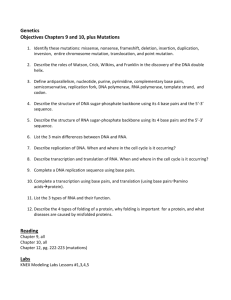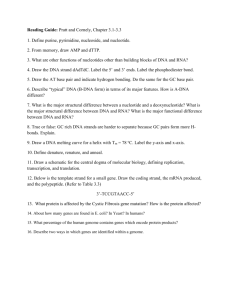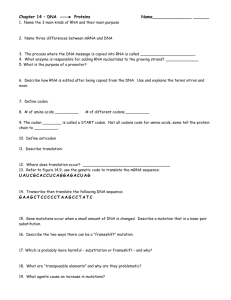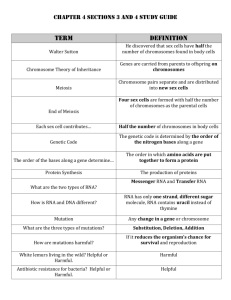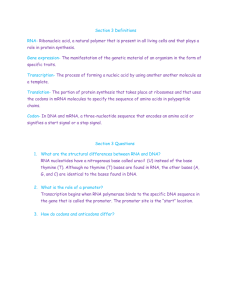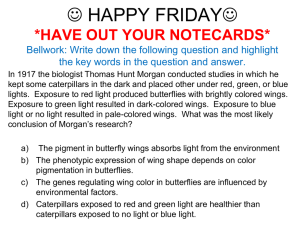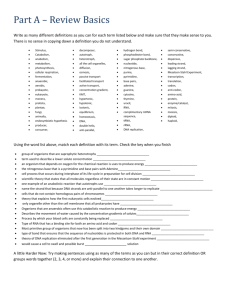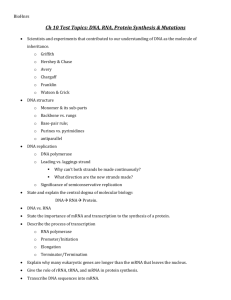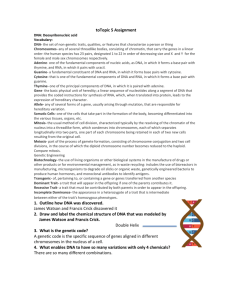Chapter 11 Genetics Sec. 11-1 The Work of Gregor Mendel Key
advertisement
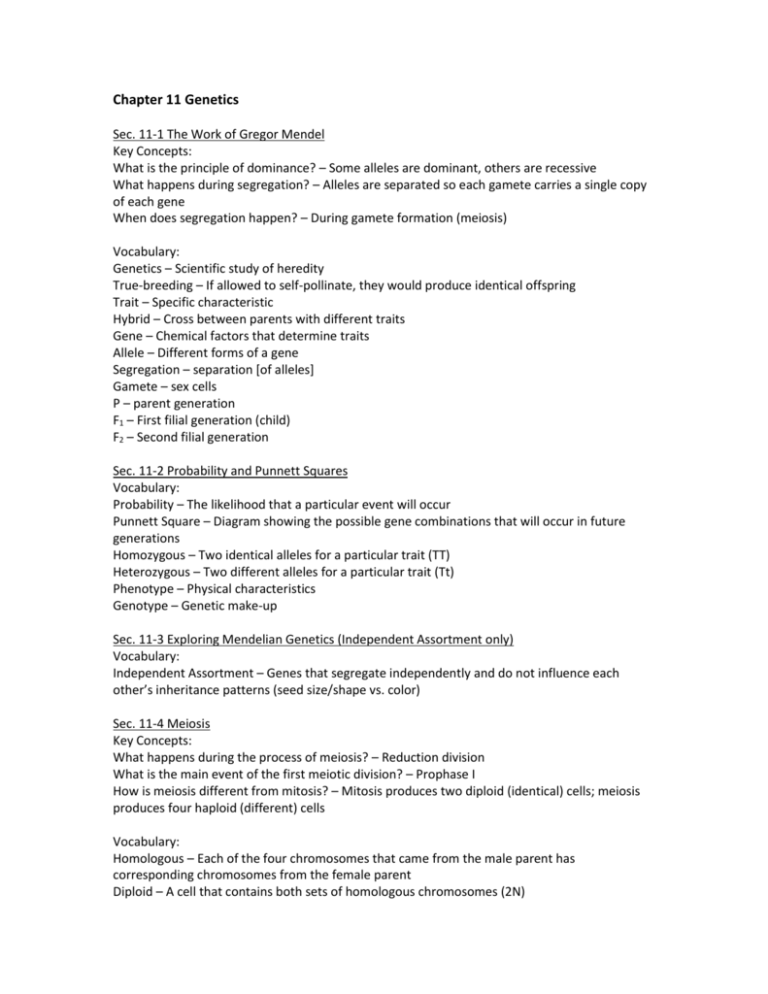
Chapter 11 Genetics Sec. 11-1 The Work of Gregor Mendel Key Concepts: What is the principle of dominance? – Some alleles are dominant, others are recessive What happens during segregation? – Alleles are separated so each gamete carries a single copy of each gene When does segregation happen? – During gamete formation (meiosis) Vocabulary: Genetics – Scientific study of heredity True-breeding – If allowed to self-pollinate, they would produce identical offspring Trait – Specific characteristic Hybrid – Cross between parents with different traits Gene – Chemical factors that determine traits Allele – Different forms of a gene Segregation – separation [of alleles] Gamete – sex cells P – parent generation F1 – First filial generation (child) F2 – Second filial generation Sec. 11-2 Probability and Punnett Squares Vocabulary: Probability – The likelihood that a particular event will occur Punnett Square – Diagram showing the possible gene combinations that will occur in future generations Homozygous – Two identical alleles for a particular trait (TT) Heterozygous – Two different alleles for a particular trait (Tt) Phenotype – Physical characteristics Genotype – Genetic make-up Sec. 11-3 Exploring Mendelian Genetics (Independent Assortment only) Vocabulary: Independent Assortment – Genes that segregate independently and do not influence each other’s inheritance patterns (seed size/shape vs. color) Sec. 11-4 Meiosis Key Concepts: What happens during the process of meiosis? – Reduction division What is the main event of the first meiotic division? – Prophase I How is meiosis different from mitosis? – Mitosis produces two diploid (identical) cells; meiosis produces four haploid (different) cells Vocabulary: Homologous – Each of the four chromosomes that came from the male parent has corresponding chromosomes from the female parent Diploid – A cell that contains both sets of homologous chromosomes (2N) Haploid – A cell contains only a single set of chromosomes (single set of genes) (N) Meiosis – Reduction division in which the chromosome number is halved through separation of homologous chromosomes Tetrad – Each chromosome pairs with its corresponding homologous chromosome Synapsis – The pairing of two homologous chromosomes during Prophase I Crossing-over/Recombination – Exchanging of portions of chromatids – happens during tetrad Sec. 11-5 Linkage and Gene Maps (Key Concept & Vocabulary only) Key Concepts: What structures actually sort independently? – Chromosomes assort independently, not genes Vocabulary: Gene Map – Shows the relative locations of each gene on a chromosome Linkage – Genes are linked (show up together consistently) so no new combinations show up; no intermediate phenotypes Chapter 12 DNA & RNA Sec. 12-1 DNA (omit scientists & classic experiments) Key Concepts: What is the overall structure of the DNA molecule? – A DNA molecule, as discovered by Watson and Crick, is a double-helix (two strands wound around each other) What are the three parts of a nucleotide of DNA? – DNA is made up of deoxyribose, phosphate, and a nitrogenous base …of RNA? – Ribose, phosphate, and a nitrogenous base (Uracil instead of Thymine) – it is also one strand Vocabulary: Nucleotide – The basic make-up of DNA; it is made up of deoxyribose, phosphate, and a nitrogenous base Base pairing – Hydrogen bonds can only form between certain base pairs—adenine with thymine, guanine with cytosine Purines – Adenine and Guanine Pyrimidines – Cytosine and Thymine Chargaff’s Rules – [A] = [T] and [G] = [C] Sec. 12-2 Chromosomes and DNA Replication Key Concepts: What happens during DNA Replication? - During DNA Replication, the DNA molecule separates into two strands, and then produces two new complementary strands following the rules of base pairing. Each strand of the double helix of DNA serves as a template, or model, for the new strand Vocabulary: Chromatin - Eukaryotic chromosomes contain both DNA and protein, tightly packed together to form this substance Histone - DNA of the chromatin is tightly packed around proteins called histones Nucleosome – Nucleosomes are the reason this length can be achieved – each nucleosome is super-coiled; nucleosomes play a role in regulating how genes are read – changes which proteins are produced Replication - Duplication of DNA before a cell divides (KEY CONCEPT: During DNA Replication, the DNA molecule separates into two strands, then produces two new complementary strands following the rules of base pairing. Each strand of the double helix of DNA serves as a template, or model, for the new strand DNA Polymerase - The principle enzyme involved in DNA replication; it polymerizes individual nucleotides to produce DNA Replication Fork - The replication fork is a structure that forms within the nucleus during DNA replication. It is created by helices, which break the hydrogen bonds holding the two DNA strands together. The resulting structure has two branching "prongs", each one made up of a single strand of DNA. Sec. 12-3 RNA and Protein Synthesis Key Concepts: What are the three main types of RNA? - Messenger RNA (mRNA), ribosomal RNA (rRNA), and transfer RNA (tRNA) What is transcription? - During transcription, RNA polymerase binds to DNA and separates the DNA strands. RNA polymerase then uses one strand of DNA as a template (model) from which nucleotides are assembled into a strand of RNA What is translation? - During translation, the cell uses information from messenger RNA to produce proteins Translation Process: o RNA transcribed from DNA o mRNA molecule in the cytoplasm attaches to a ribosome o The ribosome forms a peptide bond between the first and second amino acids, methionine and phenylalanine o The chain continues to grow until it reaches a stop codon on the mRNA molecule Vocabulary: Messenger RNA (abbreviation: __mRNA__) - The RNA molecules that carry copies of instructions from genes; they serve as “messengers” to the rest of the cell Ribosomal RNA (abbreviation: __rRNA__) - Ribosomes made up of several dozen proteins, as well as this form of RNA Transfer RNA (abbreviation: __tRNA__) - During construction of a protein, this type of RNA transfers each amino acid to the ribosome as it is specified by coded messages in mRNA Transcription - RNA molecules are produced by copying part of the nucleotide sequence on DNA into a complementary sequence in RNA RNA Polymerase - During transcription, RNA polymerase binds to DNA and separates the DNA strands. RNA polymerase then uses one strand of DNA as a template (model) from which nucleotides are assembled into a strand of RNA Promoter - The region of DNA that acts as the initial binding site for RNA polymerase Intron - A stretch of DNA that interrupts a gene and does not contribute to the specification of a protein Exon - Any segment of a discontinuous gene the segments of which are separated by introns Codon - A sequence of three adjacent nucleotides constituting the genetic code that determines the insertion of a specific amino acid in a polypeptide chain during protein synthesis or the signal to stop protein synthesis Translation - The process by which messenger RNA directs the amino acid sequence of a growing polypeptide during protein synthesis Anticodon - A sequence of three adjacent nucleotides in transfer RNA that binds to a corresponding codon in messenger RNA and designates a specific amino acid during protein synthesis Sec. 12-4 Mutations Key Concepts: What are gene mutations? - Two types of mutations: Point mutations (substitutions) Frameshift mutations (insertion/deletion) – can affect protein so that it is unable to perform properly What are chromosomal mutations? - Chromosomal mutations change the number or structure of a chromosome: Deletion Duplication Inversion Translocation Vocabulary: Mutation - Changes in DNA sequence that affect genetic information Point mutation - Mutations that affect one nucleotide; they occur in one specific place Frameshift mutation - Mutations that shift the “reading frame” of the genetic message (i.e. deletion, insertion) Chromosomal mutation (not bolded in text; see p. 308) - Chromosomal mutations change the number or structure of a chromosome: Deletion, Duplication, Inversion, and Translocation Chapter 13 Biotechnology Sec. 13-1 Changing the Living World Sec. 13-2 Manipulating DNA Sec. 13-3 Cell Transformation Sec. 13-4 Applications of Genetic Engineering Chapter 14 Human Genome Sec. 14-1 Human Heredity Key concepts: How is gender determined? - All eggs carry a single X chromosome (23X). However, half of all the sperm cells carry an X chromosome (23X), while the other half carries a Y chromosome (23Y). This ensures that just about half of the zygotes will be 46XX and half will be 46XY How do small changes in DNA cause genetic disorders? - In both cystic fibrosis and sickle cell disease, a small change in the DNA of a single gene affects the structure of a protein, causing a serious genetic disorder. Vocabulary: Karyotype – A picture of chromosomes taken during mitosis arranged in corresponding pairs Sex Chromosome – Two chromosomes (X and Y) that determine an individual’s gender Autosome – The remaining 44 chromosomes in human DNA Pedigree – Chart that shows the relationships within a family, which can be used to help with the task of determining the inheritance of a trait Sec. 14-2 Human Chromosomes **Most sex-linked traits are recessive **Most are located on the X-chromosome (passed by the mother) Key concepts: Why are sex-linked disorders more common in males than in females? - Males have just one X chromosome. Thus, all X-linked alleles are expressed in males, even if they are recessive What is non-disjunction, and what problems does it cause? - If non-disjunction occurs, abnormal numbers of chromosomes may find their way into gametes, and a disorder of chromosome numbers may result (extra chromosomes, or deleted chromosomes) Vocabulary: Sex-linked gene – Genes located on sex chromosomes; many sex-linked genes are found on the X chromosome. More than 100 sex-linked genetic disorders have been mapped to the X chromosome. Non-disjunction (“not coming apart”) – The most common error in meiosis where homologous chromosomes fail to separate Sec. 14-3 Human Molecular Genetics (Key Concepts & Vocabulary only) Key concepts: What is the goal of the human genome project? – The human genome project is an attempt to sequence all human DNA (Francis Collin & Craig Venter) What is gene therapy? – In gene therapy, an absent or faulty gene is replaced by a normal, working gene Vocabulary: DNA Fingerprinting – A powerful new tool for the identification of individuals; analyzes sections of DNA that have little or known function but vary widely from one individual to another AP Biology Laboratory 7: Genetics of Drosophila (“fly packet”) see especially Introduction & Background Flies are o Cheap o Easy to maintain o Small o Breed quickly/live a short life o Can’t hurt you
